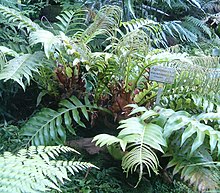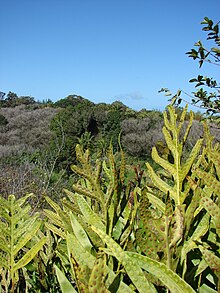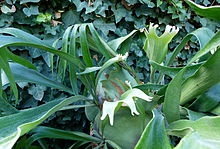Potted fern plants
| Potted fern plants | ||||||||||||
|---|---|---|---|---|---|---|---|---|---|---|---|---|

Common potted fern ( Polypodium vulgare ) |
||||||||||||
| Systematics | ||||||||||||
|
||||||||||||
| Scientific name | ||||||||||||
| Polypodiaceae | ||||||||||||
| Bercht. & J. Presl |
The potted fern family (Polypodiaceae; cf. Greek polys "much", and pous / podos "foot") form a plant family within the division of ferns (Polypodiophyta).
description
They are perennial herbaceous plants . There are many epiphytes among the potted ferns . Species of the Polypodiaceae form a creeping rhizome , which is surrounded by chaff scales. On the rhizome are the mostly poorly articulated, usually simply pinnate or pinnate fronds. The leaf blade is often relatively coarse. In many species the sterile leaves and the sporophylls are designed differently. Some species even have two types of sterile leaves ( heterophylly ).
The potted ferns get their name from the circular sori , which are usually arranged without a veil ( indusium ) on the underside of the leaves. This gives the leaves a typical stippled appearance. In some species, however, the Sori merge, so that the underside of the sporophylls is then completely covered by sporangia .
Systematics and distribution
The Polypodiaceae family was established by Bedřich Všemír von Berchtold and Jan Svatopluk Presl .
These ferns mostly thrive in the subtropics to the tropics. Only very few species also occur in the temperate latitudes, in Europe, for example, only four species of the spotted ferns ( Polypodium ). In China there are around 39 genera with around 267 species, around 82 only there (as of 2013). The potted fern plants colonize a wide variety of locations and also grow as epiphytes .
The division of the potted fern family (Polypodiaceae) is controversial. Depending on the view, there are (10 to) over 50 genera with (500 to) around 1200 species. In any case, it is the most species-rich fern family:

- Acrosorus Copel. : The approximately five species occur from Malesia to the Samoa Islands .
- Adenophorus Gaudich. : The eight or so species are only found in Hawaii .
- Aglaomorpha Schott (Syn .: Holostachyum Copel. , Merinthosorus Copel. , Photinopteris J.Sm. , Pseudodrynaria (C.Chr.) C.Chr. , Psygmium C.Presl ): The approximately 31 species thrive in tropical Asia from the Himalayas to Taiwan . The center of biodiversity is Malaysia.
- Arthromeris (T.Moore) J.Sm. (Syn .: Pleopeltis sect. Arthromeris T.Moore ): The 20 or so species thrive from subtropical to tropical Asia. There are about 17 species in China, 8 of them only there.
- Calymmodon C.Presl (Syn .: Plectopteris Fée ): The 30 species of Sri Lanka on Indomalesien spread, Australia down to the Pacific Islands. There are three types in China.
- Ferns belt ( Campyloneurum C.Presl ): The 25 to 45 species thrive in the Neotropics .
-
Caobangia A.R.Sm & XCZhang : There is only one type:
- Caobangia squamata A.R.Sm & XCZhang (Syn .: Lemmaphyllum squamatum (ARSmith & XCZhang) LiWang ): It occurs in northern Vietnam and in Guangxi .
- Ceradenia L.E.Bishop : There are about 40 species.
- Christopteris Copel. : The three or so species occur in tropical Asia, one of them in China.
- Chrysogrammitis Parris : There are about two types from Sri Lanka to China to the Pacific Islands.
- Cochlidium Kaulf. : There are about twelve types.
- Colysis C.Presl : The 30 species thrive in the tropics of Africa and Asia.
- Ctenopteris Blume ex Kunze : The approximately twelve species thrive in the tropics from Africa via China (one species) to Pacific islands.
- Dasygrammitis Parris : The six or so species occur from Sri Lanka via China (one species) to the Pacific islands.
- Dicranoglossum J.Sm. : The five or so species thrive in the Neotropic.
- Dictymia J.Sm. : Up to four species occur in Australia , New Guinea and the Fiji Islands .
- Drynaria (Bory) J.Sm. (Syn .: Polypodium subg. Drynaria Bory ): The approximately 16 species thrive in the Palaeotropic . There are nine species in China, one of them only there.
- Enterosora Baker : There are about 13 types.
- Goniophlebium (flower) C. Presl ( Syn .: Polypodium sect. Goniophlebium flower , Polypodium subg. Goniophlebium (flower) C.Chr. , Schellolepis J.Sm. ): The approximately 20 species occur mainly in tropical Asia. For example, there are two species in China and one in the Fiji Islands .
- Grammitis Sw. : There are 100 to 150 kinds.
- Gymnogrammitis Griffith : There is only one type:
-
Himalayopteris W.Shao & SGLu . This genus was established in 2011 and contains only one species:
- Himalayopteris erythrocarpa (Mettenius ex Kuhn) W.Shao & SGLu (Syn .: Polypodium erythrocarpum Mettenius ex Kuhn ): This new combination took place in 2011. It occurs in the Himalayas in Bhutan, Sikkim , Nepal and in Mêdog in Tibet.
-
Kontumia S.K.Wu & PKLoc : There is only one type:
- Kontumia heterophylla S.K.Wu & PKLoc : It occurs in Vietnam.
- Lecanopteris Reinw. : There are one to about three species in Malaysia.
- Lellingeria A.R.Sm. & RCMoran : There are about 55 species.
- Lemmaphyllum C.Presl (Syn .: Lepidogrammitis Ching ): There are up to nine types. The center of biodiversity is southern China . There are about five species in China, two of them only there. Few species exist in India, Japan , Korea , Myanmar , Thailand , Malaysia and the Philippines .
- Lepidomicrosorium Ching & KHShing : The three or so species are mainly found in central to southwest China (three species) and can also be found in northern Vietnam and the eastern Himalayas.
- Lepisorus (J.Sm.) Ching (Syn .: Drynaria . Sect Lepisorus (J.Sm.) , Belvisia Mirbel , Drymotaenium Makino , Hymenolepis Kaulfuss non . Cass , Macroplethus C.Presl , Platygyria Ching & SKWu ): Of the approximately 80 Most species occur in East Asia, a few in Africa and one in Hawaii. There are about 49 species in China, 23 of which are only there.
- Leptochilus Kaulf. (Syn .: Colysis C.Presl , Dendroglossa C.Presl , Gymnopteris C.Presl non Bernhardi , Myuropteris C.Chr. ): The approximately 25 species are widespread in Asia. There are around 13 species in China, 2 of them only there.
- Loxogramme (flower) C. Presl ( Syn .: Anarthropteris Copel. Antrophyum sect. Loxogramme Blume ): The 33 or so species are pantropically distributed, mainly in tropical Asia. One species occurs in Central America , one on the Pacific islands, and four species in Africa . There are about twelve species in China, one of which is only there.
-
Luisma M.T. Murillo & ARSm. : There is only one type:
- Luisma bivascularis M.T. Murillo & ARSm. : It occurs in Colombia .
- Melpomene A.R.Sm. & RCMoran : There are 21 types.
- Microgramma C.Presl (Syn .: Solanopteris Copel. ): The 20 to 28 species thrive in the Neotropics.
- Micropolypodium Hayata , with about 22 species
- Microsorum Link , with 33 to 60 species. They occur mainly in tropical Asia, a few in Africa; five kinds in China.
- Neocheiropteris Christ (Syn .: Neolepisorus Ching ), with about nine species
-
Neurodium Fée : there is only one type:
- Neurodium lanceolatum (L.) Fée : It is distributed from Central to South America.
- Niphidium J.Sm. : The ten or so species are common in South America .
- Pecluma M.G. Price , with about 34 species. They occur in North, Central and South America and in the Caribbean.
- Phlebodium (R.Br.) J.Sm. : The five to ten species thrive in North, Central and South America.
- Phymatosorus Pic.Serm. : The 12 to 18 species are originally found in the tropics of the Old World; but are partly neophytes in the Neotropic.
- Antler ferns ( Platycerium Desv. ): There are 9 to 18 species. Around eight species occur in Southeast Asia, around six species in Africa and Madagascar, and only one species in South America.
- Pleopeltis Humb. & Bonpl. ex Willd. : The at least 56 species thrive in America, Africa and India.
-
Pleurosoriopsis Fomin : There is only one type:
- Pleurosoriopsis makinoi (Maxim. Ex Makino) Fomin : It occurs in China, Japan, Korea and Russia.
-
Podosorus Holttum , with only one species:
- Podosorus angustatus Holttum : It occurs in the Philippines .
- Polypodiodes Ching : The approximately 17 species occur in tropical and subtropical Asia.
- Spotted ferns ( Polypodium L. ), with about 160 species
- Prosaptia C. Presl , with at least one to about 60 species. They occur from Sri Lanka and China to Australia and on the Pacific islands.
- Pyrrosia Mirbel (Syn .: Drymoglossum C.Presl ): The 60 to 100 species thrive mainly in tropical Asia, north to the Himalayas, China and Japan, östwärts to New Zealand.
- Scleroglossum Alderw. , with two to six species. They occur from Sri Lanka and China to Australia and on the Pacific islands.
- Selliguea Bory (Syn .: Crypsinus C. Presl , Polypodiopteris C.F.Reed ): The approximately 75 species are found in tropical and subtropical Asia, Australia, on islands in the Pacific, southern Africa and Madagascar.
- Serpocaulon A.R.Sm. : There are about 40 types.
-
Synammia C.Presl : There is only one way:
- Synammia feuillei (Bertero) Copel. : It occurs in Chile .
- Terpsichore A.R.Sm. : There are about 57 types.
- Themelium (T.Moore) Parris : The 20 or so species are distributed from Indonesia to the Pacific islands.
-
Thylacopteris Kunze ex J.Sm. : There is only one type:
- Thylacopteris papillosa (flower) J.Sm. : It occurs in Malesia.
- Zygophlebia L.E. Bishop : There are about eleven species.
use
Some species are used as house plants (for example the golden spotted fern ( Phlebodium aureum )).
literature
- Alan R. Smith, Kathleen M. Pryer, Eric Schuettpelz, Petra Korall, Harald Schneider, Paul G. Wolf: A classification for extant ferns. In: Taxon. Volume 55, No. 3, 2006, ISSN 0040-0262 , pp. 705-731, abstract, PDF file .
- Zhang Xianchun, Shugang Lu, Youxing Lin, Qi Xinping, Shannjye Moore, Prof. Fuwu Xing, Wang Faguo, Peter H. Hovenkamp, Michael G. Gilbert, Hans P. Nooteboom, Barbara S. Parris, Christopher Haufler, Masahiro Kato, Alan R. Smith: Polypodiaceae , pp. 758-845 - the same text online as the printed work , In: Wu Zheng-yi, Peter H. Raven, Deyuan Hong (Ed.): Flora of China. Volume 2-3: Lycopodiaceae through Polypodiaceae. Science Press and Missouri Botanical Garden Press, Beijing and St. Louis, 2013, ISBN 978-1-935641-11-7 .
Individual evidence
- ^ TG Tutin, NA Burges, AO Chater, JR Edmondson, VH Heywood, DM Moore, DH Valentine, SM Walters, DA Webb (eds.): Flora Europaea . 2nd, revised edition. Volume 1: Psilotaceae to Platanaceae . Cambridge University Press, Cambridge / New York / Melbourne 1993, ISBN 0-521-41007-X , pp. 15–16 (English, limited preview in Google Book Search).
- ↑ a b c d e f g h i j k l m n o p q r s t u v w x y z aa ab ac ad Zhang Xianchun, Shugang Lu, Youxing Lin, Qi Xinping, Shannjye Moore, Prof. Fuwu Xing , Wang Faguo, Peter H. Hovenkamp, Michael G. Gilbert, Hans P. Nooteboom, Barbara S. Parris, Christopher Haufler, Masahiro Kato, Alan R. Smith: Polypodiaceae , pp. 758-845 - online with the same text as the printed work , In : Wu Zheng-yi, Peter H. Raven, Deyuan Hong (Eds.): Flora of China. Volume 2-3: Lycopodiaceae through Polypodiaceae. Science Press and Missouri Botanical Garden Press, Beijing and St. Louis, 2013, ISBN 978-1-935641-11-7 .
- ↑ Christel Kasselmann : Polypodiaceae. In: Claus Schaefer, Torsten Schröer (Hrsg.): The large lexicon of aquaristics. Eugen Ulmer, Stuttgart 2004, ISBN 3-8001-7497-9 , p. 800.
- ↑ a b c Alan R. Smith: Polypodiaceae J. Presl & C. Presl. In: Flora of North America, vol. 2. [1] .
- ^ A b Walter Erhardt , Erich Götz, Nils Bödeker, Siegmund Seybold: The great pikeperch. Encyclopedia of Plant Names. Volume 2. Types and varieties. Eugen Ulmer, Stuttgart (Hohenheim) 2008, ISBN 978-3-8001-5406-7 .






